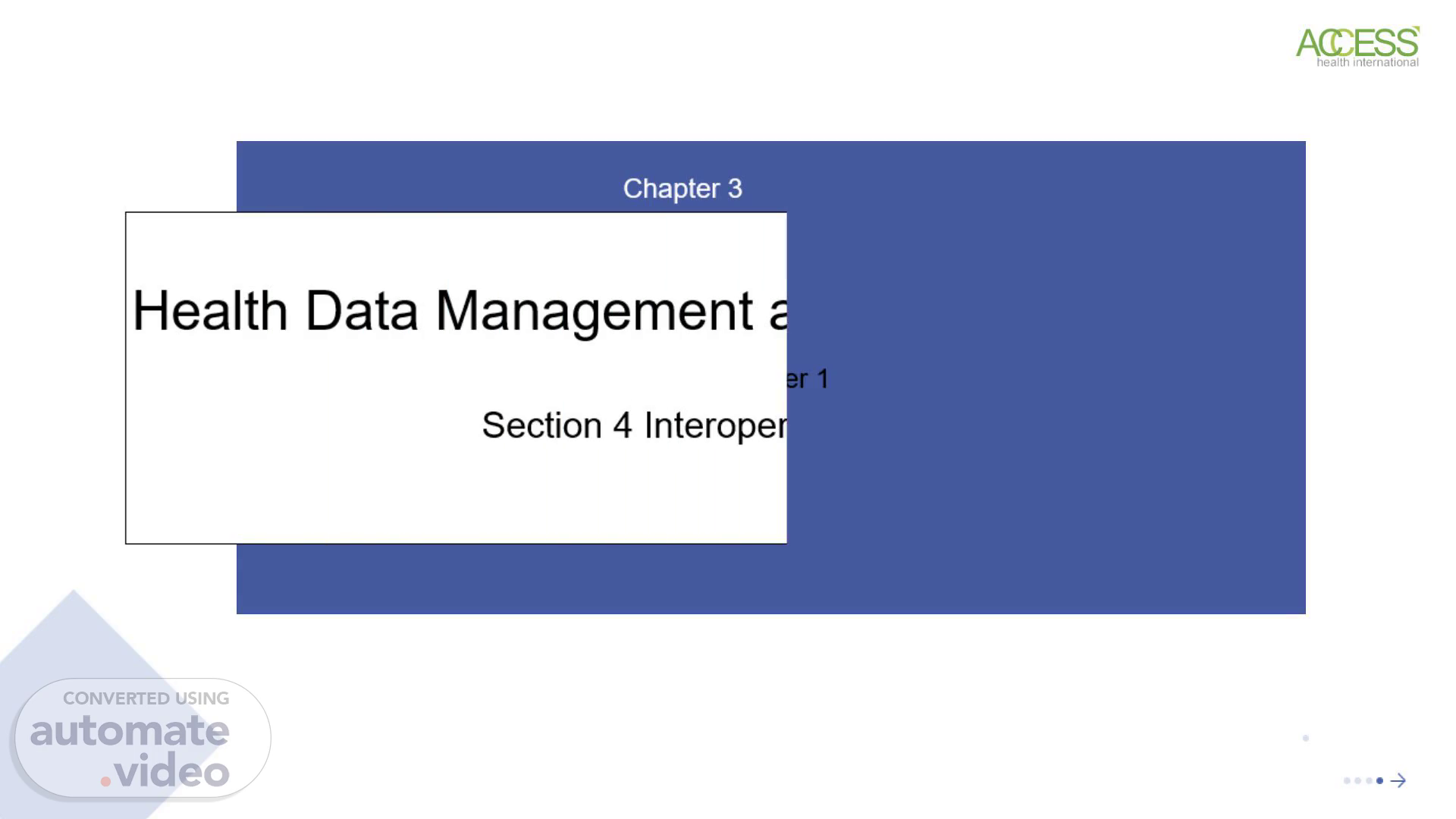
Page 1 (0s)
Chapter 1. Health Data Management and Interoperability Section 4 Interoperability.
Page 2 (7s)
Interoperability Types of Interoperability How can Interoperability improve digital medicine? Tools to analyze population health trends Benefits of Data Interoperability Case Study.
Page 3 (17s)
Semantic interoperability is more desirable than syntactic interoperability. With semantic Interoperability, the data is not only exchanged between two or more systems but also understood by each system. Syntactic interoperability allows two or more systems to communicate and exchange data, however, the interface and programming languages are different..
Page 4 (33s)
Semantic interoperability is the ability of computer systems to exchange data with unambiguous, shared meaning. Semantic interoperability is a requirement to enable machine computable logic, inferencing, knowledge discovery, and data federation between information systems. Semantic interoperability is therefore concerned not just with the packaging of data, but the simultaneous transmission of the meaning with the data (semantics). This is accomplished by adding data about the data (metadata) and linking each data element to a controlled, shared vocabulary. The meaning of the data is transmitted with the data itself, in one self-describing "information package" that is independent of any information system. It is this shared vocabulary, and its associated links to an ontology, that provide the foundation and capability of machine interpretation, inference, and logic..
Page 5 (50s)
In healthcare, NHL has been in use for over thirty years (which predates the internet and web technology) and uses the pipe character (|) as a data delimiter. The current internet standard for document markup is XML, which uses "< >" as a data delimiter. The data delimiters convey no meaning to the data other than to structure the data. Without a data dictionary to translate the contents of the delimiters, the data remains meaningless. While there are many attempts at creating data dictionaries and information models to associate with these data packaging mechanisms, none have been practical to implement. This has only perpetuated the ongoing “banalization" of data and the inability to exchange data with meaning..
Page 6 (1m 5s)
[image] 66. What is healthcare interoperability? Healthcare interoperability refers to the timely and secure exchange and use of electronic health data between different healthcare IT systems and organizations. It enables health data to be accessed and shared across clinical, public health, and research domains. Why is healthcare interoperability important for public health? Interoperability is critical for public health agencies to get comprehensive, real-time data on population health trends, disease outbreaks, high-risk groups, access gaps, and social determinants of health. This allows for evidence-based public health decision-making and interventions. For example, health information exchanges that connect data across hospitals, clinics, labs, and pharmacies provide invaluable surveillance data to health departments for infectious disease monitoring and response. Access to immunization registries and prescription drug monitoring programs via interoperability helps identify gaps in vaccination coverage and combat the opioid epidemic. Integrating health system data with community-level data on social determinants gives insights into health disparities and needs to guide targeted public health programs. And national-level interoperability enables analysis of health trends and outcomes to inform health policies and planning..
Page 7 (1m 52s)
International Cooperation. Pool data across organizations (e.g. rare disease and precision medicine). Tackle global public health issues (e.g. infection control, epidemics). Provide global access to new technologies..
Page 8 (2m 9s)
01. By analyzing historical patterns in patient data, AI algorithms can forecast outcomes and future risks for patient populations. This allows earlier interventions. Models can detect the risk of hospital readmission, sepsis onset, diabetic complications, and more..
Page 9 (2m 32s)
Tableau. A popular interactive data visualization software that can integrate data from multiple sources like EHRs, claims data, social determinants of health, etc. Tableau provides pre-built healthcare dashboards for analysis and custom dashboards can be configured to identify trends across patient populations..
Page 10 (3m 1s)
1. 2. 3. 4. 5. 6. 7. 8. Enhanced Care Coordination.
Page 11 (3m 17s)
The Michigan Health Information Network (MiHIN) is a State-designated health information exchange connecting over 100 hospitals, several thousand ambulatory practices, long-term care centers, community mental health facilities, and other providers across Michigan. Uses interoperability standards like FHIR to enable real-time data exchange between participating organizations. Serves as a bi-directional conduit between the healthcare system and public health agencies. Use Cases During the COVID-19 pandemic, MiHIN delivered daily admissions and bed capacity data from 97% of state hospitals to health authorities to coordinate response. MiHIN routes electronic case reporting of notifiable diseases from providers to public health for rapid detection of outbreaks. Data on opioid prescriptions, naloxone administrations and overdoses shared via MiHIN informs public health surveillance and interventions. Social determinants of health data from health systems integrated with other public data to identify needs and disparities for community health programs. MiHIN data used to create a statewide lead exposure registry and identify at-risk children for blood level testing and follow-up..
Page 12 (4m 1s)
Benefits Timely, comprehensive data exchange with public health agencies enables better infectious disease monitoring, emergency response, chronic disease management and health equity efforts. Interoperability expands data access for public health while maintaining patient privacy and security safeguards. Data-driven approach improves efficiency, allows targeting of resources, and measurement of population health initiatives. In summary, health information exchange through interoperability standards provides invaluable population health data to guide public health strategies while supporting coordinated, high-quality care delivery across Michigan..
Page 13 (4m 27s)
Thanks.